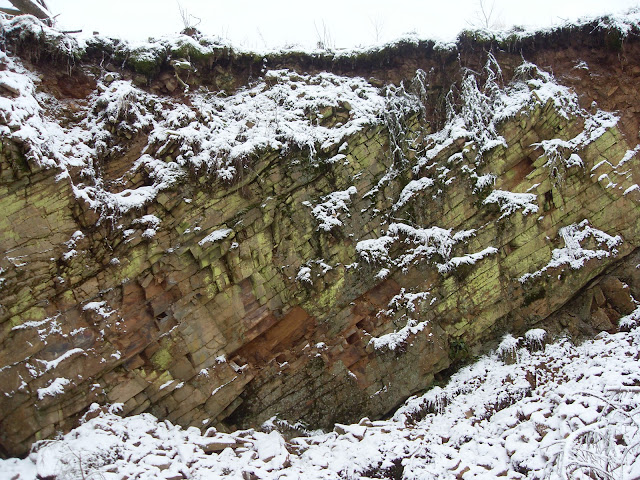Deutsch

An den Koordinaten steht Ihr vor einer Schautafel, die viele Informationen über den Steinbruch und die Gegend gibt. Hier findet Ihr auch die Antworten zu den gleich folgenden Fragen.
Dieser Sand- und Ton-Steinbruch befindet auf dem Kamm eines langgestreckten Mittelgebirgsrückens.
Zahlreiche Pingen und Erdlöcher entlang des Höhenrückens der Kalteiche bis zur Haincher Höhe sind Zeugnisse von einstigen Versuchsgrabungen im Verbreitungsgebiet der quarzitischen Sandsteine. Man suchte Gesteinslagen mit besonderer Härte, die sich gleichzeitig gut spalten ließen und in Bänken mit ausrechender Mächtigkeit auftraten.
Im vor Euch liegenden Steinbruch weisen die Sandsteine die gewünschten Merkmale allesamt auf.
1. Wieviele rein bankige Sandsteinlagen sind auf dem mittleren Bild der Schautafel ausgewiesen?
Sandsteine entstanden vor rund 395 Mio. Jahren aus Meeresablagerungen. Weite Teile Mitteleuropas waren zu dieser Unterdevon-Zeit von einem flachen Meer bedeckt. Flüsse schwemmten vom Festland gewaltige Mengen Tone und Sande ein, die sich auf dem Meeresboden absetzten. Im laufe von Jahrmillionen entstanden daraus mächtige Ablagerungen, aus denen sich nach der Devon-Zeit durch die Kräfte der Gebirgsbildung (Rheinisches Schiefergebirge) dunkle geschieferte Ton- und Sandsteine entwickelten.
Da Sandsteine meist härter und damit verwitterungsfester sind als Tonsteine, lagern diese bevorzugt im Untergrund von Bergkuppen und Höhenrücken. Die Sandsteine der Haincher Höhe bis zu Kalteiche bestehen ganz überwiegend aus harten Quarzkörnern, die außerdem noch mit Quarz (Kieselsäure SiO2) untereinander verkittet sind. Solche Sandsteine werden als "quarzitisch" bezeichnet.
Die Sandsteine im Steinbruch sind erkennbar gut gebankt. Geringmächtige Lagen aus dunklem Tonstein trennen die einzelnen Bänke. Jede Bank besteht aus vielen dünnen Sandsteinschichten. An den Fugen zwischen den Schichten zerfallen die Bänke bei der Verwitterung der Platten unterschiedlicher Größe und Dicke. Die Schichten vor Euch sind durch die bei der Gebirgsbildung wirkenden Kräfte gekippt worden.
2. Mit ca. wieviel Grad fallen die Schichten nach Südosten ein?
Auf der Schautafel findet Ihr noch eine Übersicht über die "Erdgeschichte im Überblick".
3. Welches Tier wird der Devon-Zeit zugeordnet?
4. Bitte vergesst nicht, Eurem Log ein Foto von Eurem Namen auf einem Blatt Papier bzw von Euch und Eurem GPS hinzuzufügen.
Bitte schickt Eure Antworten auf die Fragen an über das Kontaktformular an uns.
Ihr könnt sofort loggen, sollte etwas unklar sein werden wir uns melden.
English

At the coordinates you stand in front of a poster, which provides much information about the quarry and the area. Here you also find the answers to the questions below.
This sand- and clay-quarry is located on the crest of an elongated central mountain ridge.
Pings and many holes in the ground along the ridge of the cold ponds are up to the “Haincher Höhe” testimonies of former test excavations in the area of distribution of quartzitic sandstones. They tried rock layers with particular force, which could split both good and occurred in banks with ausrechender thickness.
In the past before you have the quarry sandstone to all the desired features.
1. How many purely banked sandstone layers are shown on the central image of the poster?
Sandstones came out around 395 million years from marine sediments. Large parts of central Europe were covered on this Lower Devonian time of a shallow sea. Rivers flooded a vast amount of land clays and sands, the deposits on the ocean floor. In the course of millions of years this led to massive deposits making up for the Devon-time by the forces of mountain building (Rhenish Massif) dark slated projection, sound, and sandstones.
Since sandstones are often harder and more resistant to weathering than shales, store them preferably in the background of mountain peaks and ridges. The sandstones are up to the “Haincher Höhe” to “Kalteiche” vast majority of hard quartz grains also are still (SiO2 silica) cemented together with quartz. These sandstones are referred to as "quartzite".
The sandstones in the quarry are visible well banked. Powerful low layers of dark shale separate the individual banks. Each bank consists of many thin sandstone layers. At the joints between the layers break down the benches in the weathering of the panels of different sizes and thickness. The layers have been tilted against you by the mountain building forces.
2. With about how many degrees fall layers to the southeast?
On the poster you can still find an overview of the "Earth at a Glance".
3. Which animal is assigned to the Devonian period?
4. Please, don't forget to attach a photo with your nickname on a piece of paper or of yourself with your GPS-Device.
Please send your answers to the questions by using the email-form to us.
You can log in immediately, should anything be unclear, we will contact you.